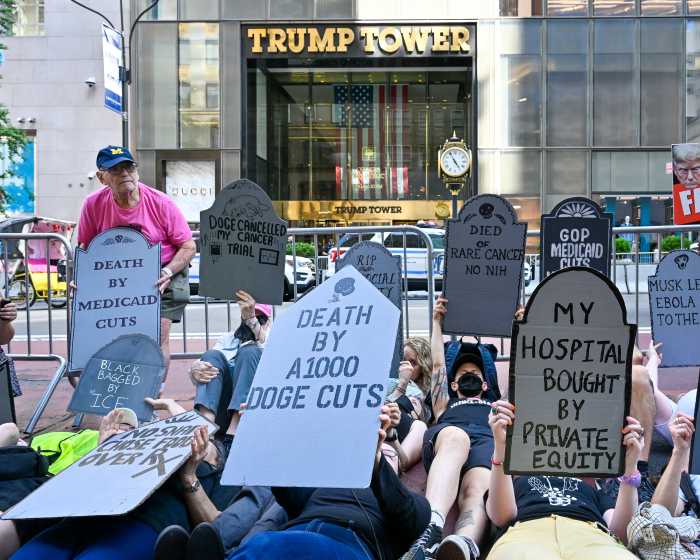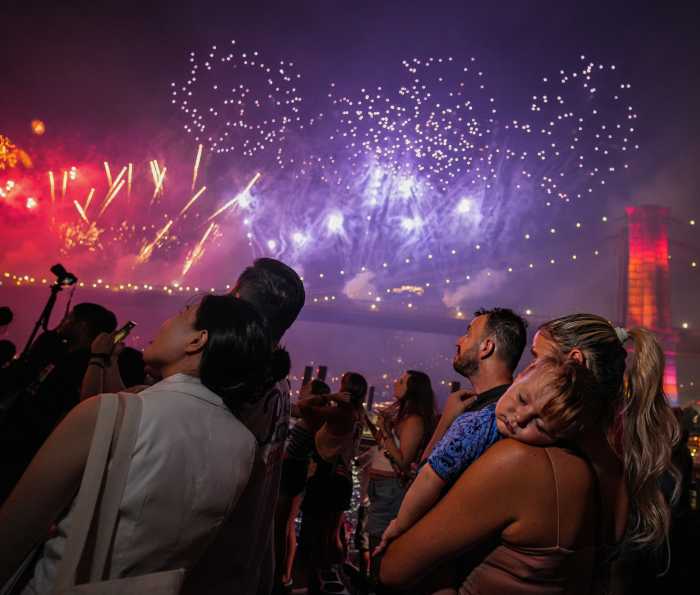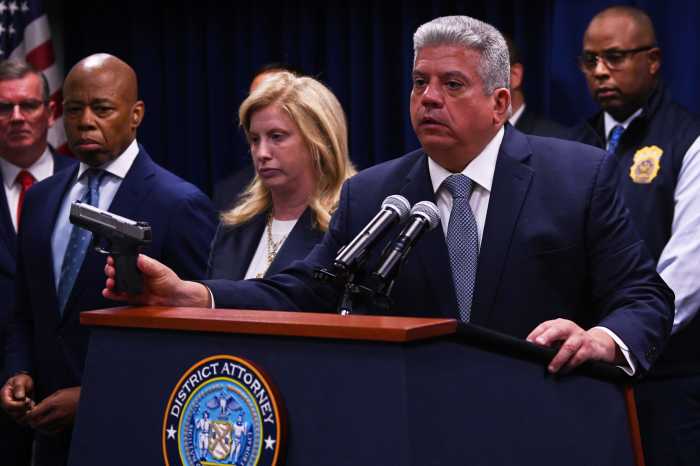
Sitting on a plush chair in his office on an upper floor of police headquarters, NYPD Commissioner James O’Neill thought back to when he started as a transit cop in 1983. He was 25 years old and the subway was a bit different than it is now.
In a wide-ranging, exclusive interview with amNewYork, O’Neill reflected on how the transit system has changed, the department’s crime-fighting challenges now and how policing in general is moving forward in the city.
O’Neill was appointed to be police commissioner by Mayor Bill de Blasio in 2016. And while he now oversees all facets of the department, he said transit will always have a place in his heart, having first become an officer with the Transit Police, which was independent from the NYPD at the time.
Despite a 3.8 percent spike in subway crime last year, O’Neill said it’s a stark difference from 1990 when crime in the subway was rampant. In fact, O’Neill said there were on average more than 47 crimes per day in the subway system in 1990, compared to about 7 per day last year. Of last year’s crimes, 1,700 were grand larcenies, which make up about 66 percent of all subway crimes (the biggest increases were seen in Manhattan and Brooklyn).

amNewYork spoke with O’Neill about everything from the latest crime statistics to fare evasion enforcement and the Neighborhood Coordination Officers program:
Grand larcenies have always been an issue in the subways. How does the department approach that problem?
There’s a couple ways we do it. Of course, we can do it through enforcement but, as what we’re doing in the precincts, there’s neighborhood policing and NCOs (Neighborhood Coordination Officers). And I think a lot of it has to do with public education. Although crime is down tremendously in the subways from what it was back in the ’90s and even the early 2000s, people still have to be mindful of what they’re displaying. If you have a chance, if you’re wearing something that’s valuable, tuck it in. … With your phones, and I talk about this all the time, maybe instead of looking at your phone during the whole ride, pay attention to what’s going on around you. … And especially if something that’s there makes you uncomfortable, you should probably let somebody know about that, that somebody being us.
How have your transit beginnings shaped your understanding of not only policing, but transit in general?
When I came out in 1983 … I went through the NYPD academy, spent three weeks in the transit academy over at Gold Street in Brooklyn, then they sent me up to District 1, which is Columbus Circle. I was there only for three weeks and then they sent me up to District 3, which is on 146th and St. Nick on the D line, and I was assigned to train patrol from 8 at night to 4 in the morning. And I rode the A train from 168th and Broadway to Jay Street in Brooklyn, I rode it from 34th and 6th on the D to Bedford Park Boulevard on the D train in the Bronx. We usually did about three round trips a night. I think that really shaped the way I see policing because it’s policing on a very humanistic level. There were certain rules of doing train patrol: You could only stay in a car for three stops and every stop you had to stick your head out the door to check out the platform, and make sure you’re wearing your hat so everybody knew that there was a cop on the train. And you could feel the sense of relief when you walked from car to car and people saw that there was a transit cop on the train. I knew for me, that was a validation for me taking the job.
How has your view of the transit system changed over the years?
I continue to care very much about it, I care deeply about it. We ride the subway when I can — not that often, but enough to see. We did a train inspection the other day down in East Broadway, whenever we have something in midtown, when I have the opportunity and actually if I’m in a rush most of the time, we’ll jump on the subway, try and take a circuitous route to come back to headquarters just to take a look at what the subway looks like and what it feels like. And it feels a whole heck of a lot different than it did in 1983 when there was graffiti all over every train, and even in trains where there wasn’t graffiti, there were all the etchings in the glass. It certainly isn’t the way it is now. I know there are quality of life issues we have to pay attention to all the time, and I think that’s why the neighborhood policing program going into the subway, into the transit districts, while at first blush you go, "I don’t know if that really makes sense because people are going from point A to point B." But when you think about it, most of the time, everybody gets on at the same stop every day and usually gets off at the same stop every day. And why not see the same cop every day … there’s some comfort in that. Maybe have a conversation, develop a relationship and put you at ease to let you know that we’re there and we’re there to keep you safe.
The NCO program launched in the transit system in April and has since expanded, but how do those roles differ from other transit police and other NCO programs?
The cops just aren’t in a booth area … they need to be there and conduct enforcement. But they also need to be in the mezzanine, they need to be in the stairs, they need to be down in the platforms, they need to be checking incoming trains as they come in — you can’t check the whole train, but you can stick your head in to a couple of cars just to make sure people feel comfortable. … It’s giving people "you own this geography," just like an NCO in a precinct. … So now you, as the NCO in District 3, you own 168th and Broadway or maybe it’s a couple stations. And then you also develop a relationship with the MTA employees, which is important, especially the station managers.
Is there data to support whether the NCO program in the trains has been effective, and is there a tangible way to track that?
Not yet. We have the Rand Corporation coming in to take a look at and assess the neighborhood policing in general. I’m probably going to ask them to see if there’s some variables that they can measure, some metrics. We will. I don’t know if anybody in the police department has had that conversation with them yet. … There’s just one other point too: it’s good for the passengers to see the same cops every day, but I think it’s really important for police morale for cops to have a sense of ownership. … I think it’s really helping us move forward at the precinct level, at the PSA (Police Service Area) level, in transit districts.
The MTA in December said there were about 208,000 people who evaded the fare each day. Andy Byford has blamed Cy Vance’s decision to decriminalize fare evasion for both declining revenue and an uptick in fare evasion. How do you feel about the decision to decriminalize, and what is the balance between preventing it and preventing the poor from being criminalized, which is what a lot of advocates are worried about?
I know Fair Fares, they started it and we’re going to increase it as we move through some time. In general, we have a good relationship with the Manhattan DA’s office. Of course at times there will be some different perspectives, maybe disagreements. Right now … if fare evasion is the only crime you’ve committed, I’m not looking to put a criminal record on you. We’re not. Our arrests are down — they were down 67 percent in 2018. But the number of people that we’ve stopped for TOS was actually up 54 percent in December. And most of them are receiving TAB [Transit Adjudication Bureau] summonses.
TOS?
Theft of services. Every transit cop knows that, it’s the Penal Law 165.15, subsection 3. It will never leave my mind. If you compare December of 2017 with December 2018, in December of ’17 we stopped 4,160 people for fare evasion and in ’18, we stopped 6,412. But most of those received either a TAB summons or a criminal court summons, so we’re not putting people through the system. It’s important to control the entry points into the subways. I think it’s important for quality of life, it’s important for passenger safety and it still has to be a big part of our strategy.
So how do you balance that?
We do it fairly. We’re not arresting as many people now. But you have to pay the fare, that’s the way the system’s set up now. It also provides revenue for the transit system. And as we move forward with Fair Fares, I think people will be more comfortable with the fare evasion enforcement that we’re doing.
Are there any efforts to potentially deter it? Perhaps placing more officers at points of entry?
We do send people out to take a look at different stations when we have complaints to see what level of fare evasion, if any, is occurring at those stations. And then we’ll redeploy if necessary.
Let’s talk about homelessness. We get emails pointing out that the population underground is growing exponentially. Are you responding to more instances of homelessness in the subways?
I’d have to get a number if that’s possible. Every police officer that’s assigned to patrol in transit, if they’re assigned stations, first thing that they’re supposed to do when they get on post is to inspect the entire station. That’s on every tour that they work, there’s midnights, 4 to 12s and day tours. We look at behavior in the subway, we don’t look at whether they’re homeless or not. We’re looking if there’s violations being committed. We do have to address it, but we’re certainly not looking to arrest homeless people, we’re looking to provide them with services. And many of them are … I don’t know if resistant is the right word, but there’s an aversion to services. And we have to contact them multiple times, we’re talking 10, 20, 30, 40 times. And sometimes we’ll be successful with getting them services and sometimes not. I know we have train patrol, which we re-instituted … I think it’s from 6 at night to 2 in the morning. We have 150 people assigned to that. Obviously you can’t cover every train run, but I think that’s important. And they’re inspecting those trains too. That’s what I did when I first came on.
Are you coordinating with other agencies in the city?
We have our homeless outreach, we coordinate with DHS [Department of Homeless Services]. We coordinate with NGOs, non governmental organizations, such as the Bowery Residency Committee. We work with them very closely to make sure that whenever we do have a contact, it’s a substantive effort to get them into shelter.
Is there a protocol when a police officer encounters a person who is homeless?
If there are no violations being committed, they’re sitting on the subway obeying the rules and regulations of the transit system, that would be up to — I would hope that the NCO or the cop assigned to that station would have a conversation with that person. I think we have an obligation to make sure that we see how they’re doing. And it doesn’t have to be somebody from homeless services to offer them services, it doesn’t have to be someone from DHS or BRC. Any patrol officer can do that. I think it’s important.
So it’s largely up to discretion?
Yeah, but we push the message out there that if there’s somebody obviously homeless, we want to see what we can do to get them to a better life.
The MTA is working to improve train speeds, but when there is an emergency or police activity, that obviously slows things down. Are you working with the MTA at all to mitigate the amount of time service is disrupted for police activity?
That is something that’s been since I was a transit cop in 1983 at times. I don’t think they’re conflicting goals because they understand — the MTA, the NYC Transit understands — that we have to keep passengers safe. If there is a crime on the subway that requires a crime scene, we have to do that in order to make sure that if there’s an outstanding subject, we can do whatever we can to make sure we apprehend that subject. If there is a train being held, believe you me, we are in constant contact with NYC Transit to make sure that we can get that train moving as quickly as possible. A lot of times if the crime occurred on the subway car, we can move that train into a side track where we can process the crime scene as necessary.
Is there an average length of time that it takes for a police situation to be processed?
It depends. It depends on what the incident is.
SUBWAY CRIME STATISTICS
Breakdown of grand larcenies in 2018, including:
Sleeping Passengers — 508
Bag picks — 355
Hand Snatches — 290
Unattended Property — 215
Pickpockets — 165
Breakdown of Grand Larcenies by borough:
Manhattan — 754
Brooklyn — 474
Bronx — 250
Queens — 222
Transit crime in 1990 vs 2018:
17,497 total index crimes vs. 2,569 total index crimes
Homicide: 26 vs. 1
Rape: 33 vs. 2
Robbery: 9,297 vs. 485
Assault: 1,353 vs. 370
Burglary: 174 vs. 11
Grand Larceny: 6,614 vs. 1,700
Booth Robbery: 159 vs. 2




























